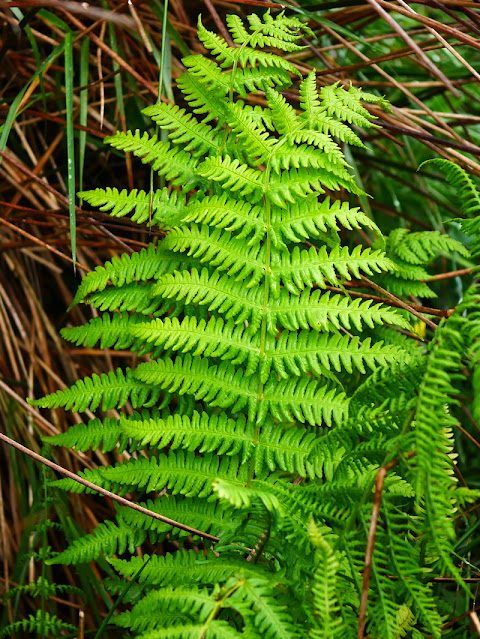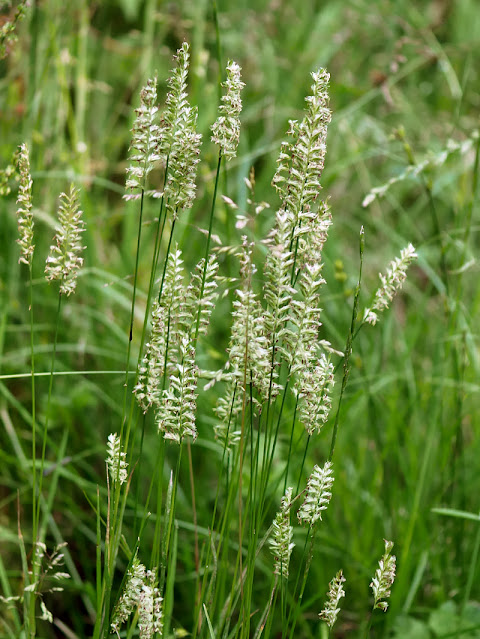There was a BioBlitz organised for Colliford Lake, Cornwall's largest reservoir situated on the Bodmin Moor, so I went along to see what I could find for their records. I didn't find any new plant species, but it was great fun looking around the draw down zone of the lake. The usual plants here are tiny, such as this Allseed below. From a standing height it looked a bit like a very small inflorescence of Stagshorn Plantain and knowing that isn't found here, I bent down to take a look. Unfortunately, the flowers were closed as it was a cloudy, drizzly sort of day.
Linum radiola
On the short, sheep grazed turf above the highest water mark was Lousewort. It flowers quite early, in Spring, but the odd plant flowers on until Summer, as below.
The next photo shows a Lousewort in seed, its inflated capsules containing the seed, much like Yellow Rattle and coincidentally, both species are semi-parasitic on neighbouring plants.
Pedicularis sylvatica
Mouse-ear Hawkweed grew here too with its lovely red tinged ligules closed for the rainy day. It also has long hairs on the mouse ear shaped leaf edges pointing inwards, hence its common name.
Pilosella officinarum
Being a BioBlitz I was also photographing and recording insects along the way.
Below is a Cinnabar Moth and it's caterpillars feed exclusively on Ragworts. They are immune to the poisons within Ragwort and use it to protect themselves from predation by birds, amphibians etc.
Tyria jacobaeae
I had no idea what caterpillars these were having never seen the like of them before. My Twitter friends informed me they were the early instar form of the Emperor Moth caterpillars, amazing. More about these caterpillars later in the blog.
Saturnia pavonia
The 5 Spot Burnet Moths were spotted on the wing, mating, emerging from the pupae case and here below as caterpillars. They feed exclusively on either Lotus corniculatus or Lotus pedunculatus (Common and Greater Birdsfoot Trefoils), depending on the sub species of moth.
See: https://butterfly-conservation.org/moths/five-spot-burnet
Zygaena trifolii
We recorded many species of plants for South West Lakes Trust's Bioblitz and a big thank you to their representative, Angellese for leading the event and collating the information.
On the drive home, I took the scenic route through the moor and came to an abrupt halt when I spotted three Greater Butterfly Orchids on the side of the road. They were a bit past their best, unsurprising, given the lack of rain, but great to find and a new monad record too.
Platanthera chlorantha
Sheep's-bit grew along the road verges too. I'm so used to it being seen at coastal locations, I sometimes forget it's also an inland plant, the clue is in its scientific name "montana" (upland/mountainous).
Jasione montana
One Sunday, I decided to record the Port Gaverne area, close to the home of the "Doc Martin" TV series at Port Isaac, for no other reason, than I like being near the sea. I recorded well over 200 plant species here and a fair few were naturalised alien species or garden escapes like the one below.
This is the Orange Day-lily. It has quite a large flower and it's the second one I've seen in the wild in Cornwall in a year and a half of living here. It doesn't seem invasive like Montbretia and doesn't seem to spread much. I know this because, this species was recorded here 9 years ago and it hasn't spread in that time. It's certainly an attractive flower and I can see why gardeners grow it.
Hemerocallis fulva
On the coastal cliffs were hundreds of Narrow-leaved Everlasting Pea which is our native Pea species. The flowers are fewer and duller than the alien Broad-leaved Everlasting Pea and of course, the leaves are at least six times longer than wide, not fat and in your face like the alien one!
Lathyrus sylvestris
Crested Dog's Tail is a common, but attractive grass. You can spot it growing quite early on, but it takes a while for the spikelets to open up. When they do and they catch the light, they look amazing. I didn't quite catch the light here, but you get the idea.
Cynosurus cristatus
Musk Mallow was, and still is, putting on fine displays in various places. The one below was at Port Gaverne, but I have seen it on many road verges and roundabouts. The drought hasn't bothered it at all. One plant near me, came into flower in Summer last year and was still in flower for the New Year Plant Hunt on New Year's Day! I used to think these were a plant of calcareous places, but they can tolerate a degree of acidity and our road verges are not too acid for the most part for them.
Malva moschata
A 15 minute drive from my home is Pentireglaze, a lovely small beach with abutting cliffs and an abundant flora including one of Cornwall's coastal specialities, Babington's Leek, which has now come into flower. They are a tall plant, often growing to 3, maybe 4 feet tall with a clustered ball of purple flowers. I do like them.
Allium ampeloprasum var. babingtonii
It was late evening when I walked up the valley at Pentireglaze, so the dragonfly below was roosting. When they are on the wing, they are hard to chase down for a photograph as they are so active. so the middle of the day is not such a good time to take their picture.
This stunner is called a Golden-ringed Dragonfly.
Cordulegaster boltonii
On a field edge, I found a few Corn Marigolds. These are naturally occurring in Cornwall and (for the most part) are not arising from wildflower seed mixes or bird seed feeders. They're bright and cheerful aren't they.
Glebionis segetum
From big, in your face flowers, to the tiny ones you walk past without knowing it. On the same walk, I found some tiny Knotted Hedge Parsley, probably only a few inches tall. They can grow to around a foot tall, but the lack of rain has stunted them in height I think.
Torilis nodosa
In the last week of June, I went to Cubert Common, South of Newquay for a look around. The walk took me into one edge of Holywell dunes too, so it was very scenic. One of the plants I found was the white form of Black Horehound. I've seen it before in Kent, but it is very uncommon. They are usually dirty pink/light purple colour. It seems all the Black Horehound in Cornwall is subsp meridionalis, so I looked up what this meant. Basically, the main difference is that the calyx is wider than long. In subsp nigra, the calyx is longer than wide. Seems odd having a subspecies name for such a small difference, perhaps the chromosome count is different too.
Ballota nigra subsp meridionalis (var. albiflora)
The stunning piercing blue of Brooklime, a Speedwell that likes to grow in very damp conditions, in this case, on the edge of a streamlet. It's a shame their flowers are tiny, otherwise they would be grown in gardens I think.
Veronica beccabunga
A beautiful view from Holywell Dunes and a habitat photo for Sea Holly and Sea Bindweed amongst lots of other sand loving species.
Here is one of hundreds of Sea Holly plants, with most coming into flower. The bumblebees loved them too. There's actually a brownish crab spider under the flower with a flying insect it caught there.
Eryngium maritimum
Common Poppies and Corn Marigolds at West Pentire. The place was crowded with tourists all there to see the poppies. This was a shame as there was so much trampling of the field edges that the National Trust has had to rope off all the fields. I had hoped to wander up the field edges for some arable rare plants, but that was not to be.
Do we really need a crop of poppies in an arable field noted for rare plants?
My last excursion in June was with the Cornwall Botany Group, where we surveyed and recorded Creney Farm, South of Lostwithiel. Cornwall Wildlife Trust had purchased the farm to join up the landscape with three adjoining nature reserves. So the purpose of our visit was to identify plants (and insects) and record what was already there. That is essential to know before any work is done on this new reserve. Without such knowledge, rare plants or insects could be inadvertantly wiped out by "improving" areas, ironically for wildlife! So it was great to listen to a CWT representative talk about their plans for the reserve and how to best create habitats for all forms of wildlife.
Below, the group was making its way through rush dominated grassland that had been partially drained and "improved" for farming by the previous owners. The "improvements" failed and farming was not worthwhile in some of these fields. Here, we found remnants of good bog habitat that could be restored, with plants such as Marsh Cinquefoil, Marsh St. John's Wort and Marsh Speedwell all still present.
Some of the plants found here included:
Marsh Pennywort with its tiny umbel of flowers
(you don't think of this plant as being an umbellifer, but it is)
Hydrocotyle vugaris
Heath Rush with its tufted leaves flattened at the base and an inflated sheath around the spikelet node. I'd been struggling working out Juncus species without taking a sample home to study, so it was great to be given hints on its form by the Vice County Recorder and how to easily identify such species quickly.
Juncus squarrosus
Lesser Skullcap, which grows in boggy, damp and acidic places.
Scutellaria minor
Harestail Cottongrass with its single seed head (as opposed to the three in Common Cottongrass).
Eriophorum vaginatum
Common Valerian with its typical branched flower spikes and pom poms of little flowers. This really is quite common in Cornwall, but quite rare in Kent. I suspect that's simply because Cornwall has so much more damp habitats than Kent, which this species likes for sure.
Valeriana officinalis
Below was our final find from this day, another caterpillar that I didn't recognise. Well, it's the Emperor Moth caterpillar again, but this time, it's the final instar form before it pupates for the Winter to hatch as one of the UK's most magnificent moths in the Spring. What an amazing caterpillar!
Saturnia pavonia
Have a look here for photos of this beautiful moth.
https://butterfly-conservation.org/moths/emperor-moth
That rounds up June. The weather experts tell us it's been the warmest June on record and it was certainly the driest I can ever recall, following on from a very dry May too. As I write this on the 5th July, I am pleased to say it's been raining heavily for two days of July already, with some more forecast. Hopefully, some annual plants may now germinate and continue into September, providing we don't get any extended long hot and dry periods again. Sunny days, rain overnight, that's all I ask....
I often compare the Cornwall flora to Kent, where I used to live. It occurred to me that readers might like to see the Kent flora too, so if chalk flora and plants from Late Spider Orchids to Bastard Cabbage interest you, have a look at https://barbus59.blogspot.com/ or for my Kent blogs as a beginner, see https://barbus59.tumblr.com/archive (scroll down to view individual blogs in date order).
Take care
Dave















































































